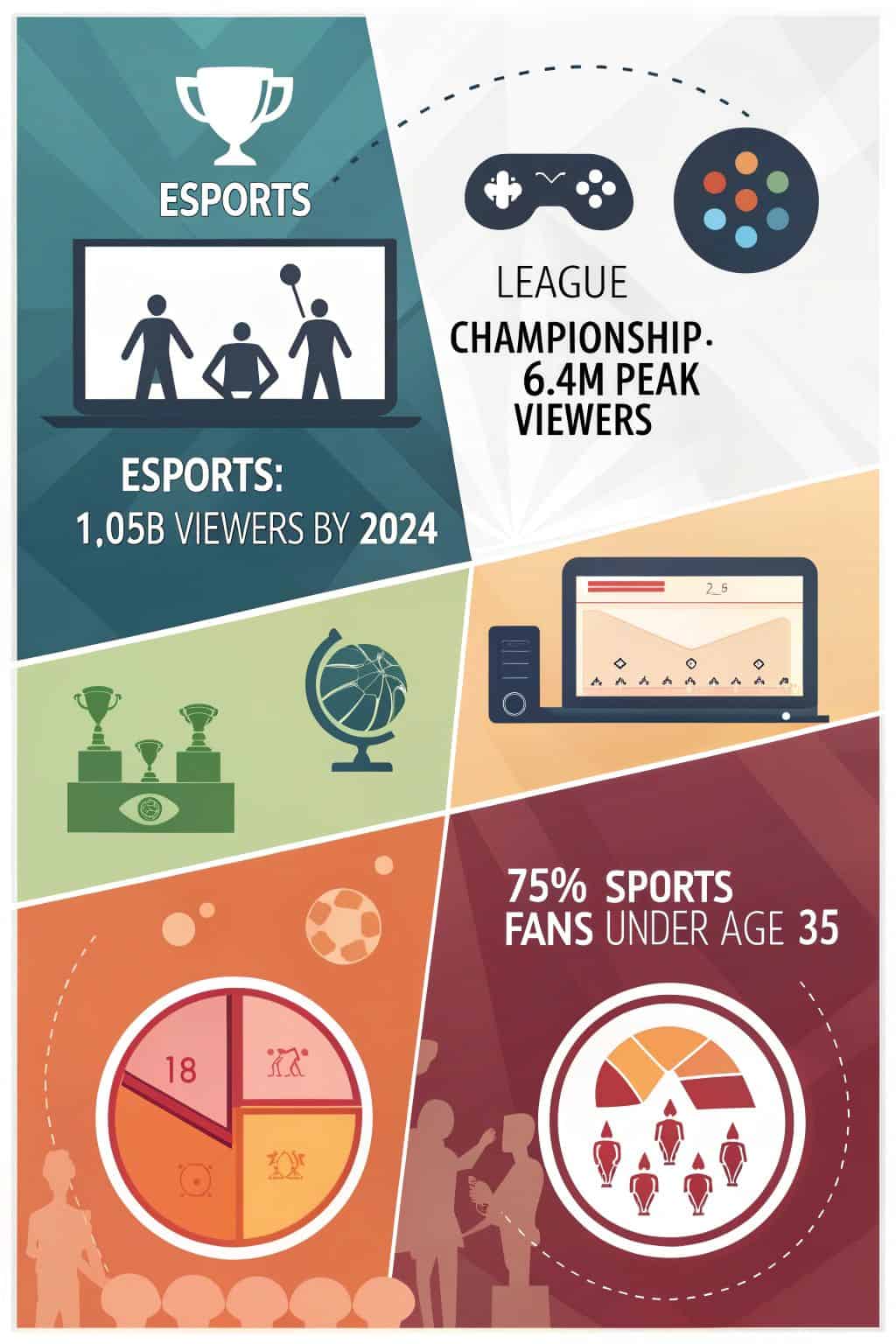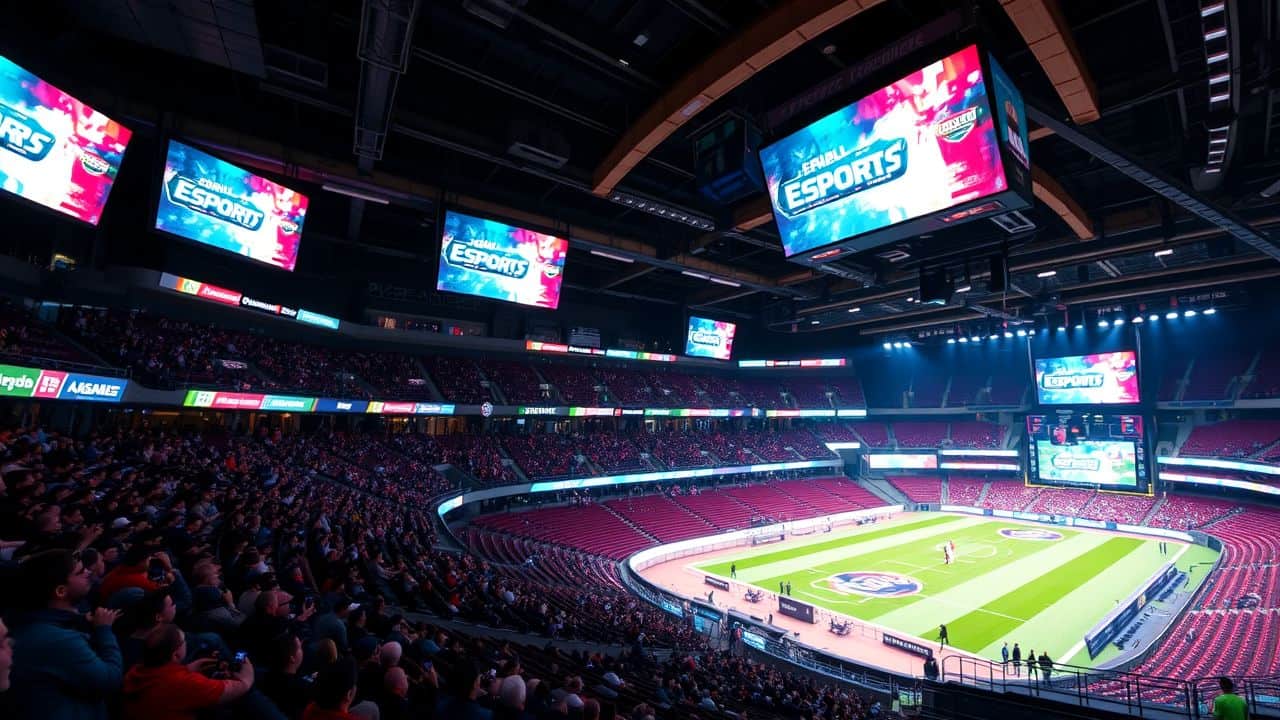Esports vs sports viewers – it’s the new hot topic in entertainment. Fans are switching sides faster than you can say, “game on.” Did you know that esports events now fill huge stadiums like Beijing National Stadium? This blog will show you eight wild trends changing how we watch games.
Ready for some mind-blowing facts? Let’s go!
Key Takeaways
Esports viewership is growing fast, with 593.2 million viewers in 2019 expected to reach 1.05 billion by 2024.
The League of Legends World Championship 2023 had 6.4 million peak viewers, while Super Bowl LVII had 115 million TV viewers plus 21.81 million streaming viewers.
Esports fans are younger, with 75% under age 35, compared to 38% for traditional sports. Esports also has more female viewers at 25% versus 17% for traditional sports.
Esports prize pools are growing but still trail top sports salaries. The biggest esports prize pool was $40 million for DOTA 2’s The International, while NFL star Patrick Mahomes earns $45 million per year.
By 2030, the esports industry is forecast to reach $12 billion in revenue, five times its current size. Over 50 countries now officially recognize esports as a sport.
Table of Contents
Overview of Esports and Traditional Sports

Esports and traditional sports are like night and day. They’re both games, sure, but that’s where the similarities end. Esports happen on screens with controllers or keyboards, while regular sports need fields, courts, and a whole lot of sweat. The eSports betting market as reported by iGamingNuts shows just how popular competitive gaming has become.
Gameplay and Rules Differences
Traditional sports and esports are like night and day. Sports need real fields and physical skills. Esports happen on screens and need quick thinking. In football, you run and tackle.
In League of Legends, you click and strategize. Sports rules stay the same for years. Esports rules change fast with new game updates.
Esports don’t split players by size or gender like sports do. Anyone can play against anyone. This makes esports more open but also more complex. As sports betting grows, so does esports betting.
Both need skill to win, but in different ways.
Esports are like chess on steroids – fast-paced, ever-changing, and accessible to all, says Ninja, a famous streamer.
Skill Requirements in Esports and Sports
Esports and sports both demand top-notch skills, but in different ways. Gamers need lightning-fast reflexes and razor-sharp focus. They must think on their feet and solve problems in seconds.
It’s not just button mashing – pro gamers use complex strategies and teamwork. On the flip side, athletes train their bodies to peak form. They build strength, speed, and agility through grueling workouts.
Both fields require mental toughness and the ability to perform under pressure.
Interestingly, many esports teams now include fitness in their training. They know a healthy body helps the mind stay sharp. This shows how the two worlds are starting to overlap. Some skills, like quick decision-making and teamwork, are crucial in both arenas.
As we dive deeper, we’ll see how these different skill sets shape the viewing experience for fans.
Viewership Trends Over Time

Esports viewership is skyrocketing! Traditional sports are seeing a dip in their numbers. This shift is changing how we watch and enjoy competitive entertainment.
Esports Viewership Data
 Esports viewership is soaring. Check out these incredible numbers that show its massive growth.
Esports viewership is soaring. Check out these incredible numbers that show its massive growth.
| Event | Year | Peak Viewers |
|---|---|---|
| M5 World Championship (Mobile Legends) | 2023 | 5.06 million |
| League of Legends World Championship | 2023 | 6.4 million |
| Free Fire World Series Singapore | 2021 | 5.41 million |
| League of Legends World Championship | 2021 | 4.01 million |
These numbers are crazy! The growth is real, folks. More people are watching pro gamers compete than ever before. It’s amazing to think about how far we’ve come.
Years ago, watching esports vs traditional sports wasn’t even an option. Now? It’s totally different. Esports events are attracting millions of viewers, competing with some major sports broadcasts.
What’s behind this surge? For one, it’s much easier to watch now. Streaming platforms like Twitch and YouTube Gaming have made it simple to see your favorite players in action. Plus, these events are incredibly well-produced. It’s not just watching a game – it’s an experience.
And let’s not forget the games themselves. They’re getting more exciting, more competitive, and easier to follow. No wonder people are hooked!
Traditional Sports Viewership Data

Traditional sports viewership data paints an interesting picture. Let’s dive into some numbers that might surprise you.
| Event | Viewership | Year |
|---|---|---|
| Super Bowl LVII | 115 million (TV) + 21.81 million (streaming) | 2023 |
| Super Bowl LVI (including gatherings) | ~208 million | 2022 |
Holy moly! Those are some big numbers, right? The Super Bowl’s pulling in viewers like nobody’s business. But here’s the kicker – cable TV use is dropping. That might shake things up for traditional sports ratings. It’s like watching a high-stakes game… but with viewer numbers instead of touchdowns.
Key Events in Esports and Sports

Esports and traditional sports both have their big moments. The Super Bowl draws millions of TV viewers, while League of Legends World Championships pack online streams. These events show how fans engage differently with digital and physical sports.
Comparing Super Bowl and League of Legends World Championships
Let’s dive into the epic showdown between the Super Bowl and League of Legends World Championships. These giants of entertainment are reshaping how we view sports and esports. Check out this comparison:
| Aspect | Super Bowl | LoL World Championships |
|---|---|---|
| Peak Viewership | 115 million (2023) | 6.4 million (2023) |
| Highest Live Attendance | 103,985 (1980) | 47,268 (2016) |
| Venue | Massive stadiums | Large arenas |
| Broadcast | TV networks | Streaming platforms |
| Global Reach | Mainly US-centric | Worldwide audience |
| Duration | One day | Multi-week tournament |
While the Super Bowl still dominates in raw numbers, LoL Worlds is catching up fast. The digital nature of esports opens up new ways for fans to engage. Next, let’s explore the viewer demographics that shape these events.
Audience Size and Engagement
Esports events are pulling in massive crowds, rivaling traditional sports. Check out these mind-blowing numbers:
| Event | Audience Size | Engagement Metrics |
|---|---|---|
| League of Legends Worlds 2023 | 6.4 million views | Millions of chat messages, fan art submissions |
| Super Bowl LVII | 115 million TV viewers, 21.81 million online streamers | Billions in ad revenue, trending on social media |
Crazy, right? Esports are catching up fast. The gap’s shrinking year by year. Fans aren’t just watching – they’re part of the action. They chat live, create content, and even influence gameplay. It’s a whole new ball game… or should I say, keyboard game? Now, let’s dive into the tech that’s making this possible.
Viewer Demographics

Esports fans are young and global. They’re not your typical sports crowd – think teens and twenty-somethings from all corners of the world.
Age Distribution and Global Reach
Esports fans are young and global. Most are under 35, while traditional sports attract older viewers. Let’s break it down:
| Age Group | Esports Viewers | Traditional Sports Viewers |
|---|---|---|
| Under 18 | 22% | 9% |
| 18-34 | 53% | 29% |
| 35-54 | 20% | 39% |
| 55+ | 5% | 23% |
Globally, esports is huge in Asia. China and South Korea lead the pack. But it’s growing fast in North America and Europe too. The sports vs video games debate is gaining traction worldwide.
I’ve seen this firsthand at gaming events. Teens and twenty-somethings pack the stands. They’re from all over – speaking different languages but united by their love of gaming.
Those 1.05 billion live-stream viewers I mentioned earlier? They’re spread across the globe. That’s a lot of eyeballs on screens!
Next up, let’s talk about how tech is changing the game for viewers…
Gender Diversity Among Viewers
Moving from age and global reach, let’s dive into the gender mix of esports and traditional sports viewers. It’s an eye-opener!
| Aspect | Esports | Traditional Sports |
|---|---|---|
| Male Viewers | 75% | 83% |
| Female Viewers | 25% | 17% |
| Inclusivity | High – open to all backgrounds | Varies by sport |
| Gender Barriers | Low – skill-based | Can be high – physical differences |
| Growth in Female Viewers | Rapid | Slow but steady |
Whoa, check out those numbers! Esports is killing it with female viewers. While the boys still rule the roost, girls are jumping on the esports bandwagon fast. It’s like esports rolled out the red carpet for everyone.
Traditional sports? They’re still a bit of a boys’ club. But hey, times are changing. More women are tuning in to watch the big game, too.
Here’s the kicker – esports doesn’t care who you are or where you’re from. Got skills? You’re in! This open-door policy is a game-changer. It’s drawing in viewers from all walks of life.
So, what’s next? Will esports keep leading the charge in viewer diversity? Or will traditional sports catch up? Only time will tell, but one thing’s for sure – the viewing landscape is shifting fast!
Technology’s Role in Viewership

Tech has flipped the script on how we watch games. Twitch and YouTube Gaming have become the go-to spots for esports fans, while cable TV still holds its ground for traditional sports buffs.
Esports on Streaming Platforms
Streaming platforms have become the go-to spot for esports fans. Twitch and YouTube Gaming lead the pack, offering live matches and pro-player streams. These sites let viewers chat in real-time, creating a buzzing community vibe.
It’s like being at a sports bar, but from your couch!
The numbers don’t lie – esports viewership is booming. In 2019, 593.2 million people watched live-streamed gaming. By 2024, that number will hit 1.05 billion. That’s nearly double in just five years! Big events draw massive crowds too.
The League of Legends Worlds 2023 pulled in 6.4 million viewers. Brands are taking notice – KitKat just renewed its League of Legends partnership until 2027.
Traditional Sports on Broadcast Channels
Broadcast channels have been the go-to for sports fans for decades. They bring the big games right to our living rooms. Think Super Bowl, World Series, or NBA Finals. These events draw huge crowds.
Take Super Bowl LVII in 2023. It pulled in a whopping 115 million TV viewers in the US alone. That’s a lot of chips and dip!
But it’s not just about TV anymore. Streaming is changing the game. For that same Super Bowl, another 21.81 million folks watched online. It’s a sign of the times. Broadcast channels are adapting.
They’re offering apps and websites to stream live games. They know fans want options. The next section will dive into how this shift impacts the money side of sports viewing.
Economic Impact of Viewership

Esports prize pools are blowing up! They’re now rivaling big-time sports salaries. Ads and sponsors are jumping on board too, but in different ways than traditional sports.
Comparing Esports Prize Pools to Sports Salaries
Esports prize pools are skyrocketing, giving traditional sports a run for their money. Let’s break down the numbers and see how they stack up.
| Esports | Traditional Sports |
|---|---|
| DOTA 2 The International: $40 million prize pool | NFL’s Patrick Mahomes: $45 million/year contract |
| League of Legends Worlds 2023: $2.23 million total prize | NBA’s Steph Curry: $48 million/year salary |
| LoL Worlds 2023 winner’s share: $445,000 | MLB’s Max Scherzer: $43.3 million/year contract |
| Individual LoL Worlds 2023 winner: $157,000 | NHL’s Connor McDavid: $12.5 million/year salary |
Esports prizes are growing fast, but still lag behind top sports salaries. Pro gamers often rely on streaming and sponsorships to boost their income. The gap is closing, though. As esports viewership rises, so do the rewards. Next up, let’s peek into the crystal ball and see what the future holds for both industries.
Differences in Sponsorship and Advertising
Sponsorship and advertising in esports are evolving at warp speed. Let’s break down how they differ from traditional sports.
| Aspect | Esports | Traditional Sports |
|---|---|---|
| Sponsor Types | Tech brands, energy drinks, gaming gear | Banks, car makers, beer companies |
| Ad Placement | In-game banners, stream overlays | Stadium signs, TV commercials |
| Audience Reach | Global, mostly online | Regional, mix of TV and live events |
| Brand Integration | Deep, often part of the game itself | More traditional, separate from play |
| Revenue Share | 75% from media rights and sponsorships | Varied, includes ticket sales and merch |
Big names like AUDI, BMW, and RED BULL are jumping into esports. It’s not just game companies anymore! KitKat even renewed its League of Legends deal until 2027. That’s some serious long-term faith in digital competition.
Now, let’s peek into the crystal ball and see what the future holds for viewership…
Predictions for the Future of Viewership

Esports viewership is set to skyrocket in the coming years. Traditional sports might need to up their game to keep fans glued to screens.
Growth Forecast for Esports
Esports is on fire! By 2030, it’s set to rake in a whopping $12 billion. That’s five times more than now. Crazy, right? More and more folks are tuning in to watch gamers do their thing.
In 2019, about 593 million people watched live gaming. Fast forward to 2024, and that number’s gonna hit over a billion. Talk about a growth spurt!
Countries are jumping on the esports bandwagon too. Over 50 nations now say it’s a real sport. South Korea, China, Denmark, Russia… they’re all in. It’s not just for fun anymore – it’s big business.
With more viewers, more money, and more recognition, esports is set to level up big time in the coming years.
Viewing Trends in Traditional Sports
Traditional sports are changing how people watch them. Cable TV use is going down, which might mean fewer folks tuning in to big games. But that doesn’t mean sports are losing fans.
The 2023 Super Bowl broke records with 115 million US viewers! Sports leagues are getting creative, too. They’re trying out virtual formats to keep fans hooked. Formula One, NBA, NHL, and even athletics are jumping on this trend.
Sports fans are finding new ways to catch the action. Streaming services are becoming more popular for watching games. This shift lets viewers watch on their own schedule. It’s not just about sitting on the couch anymore.
Fans can now watch on phones, tablets, or computers – anywhere, anytime. This flexibility is changing how we think about game day.
People Also Ask
How are esports tournaments changing the entertainment landscape?
Esports tournaments are shaking things up big time. They’re pulling in massive crowds, both online and in-person. Take the Fortnite World Cup, for example. It’s not just a game anymore – it’s a spectacle. Fans are glued to their screens, watching pros duke it out in real-time strategy battles. It’s a whole new ball game in the world of entertainment.
What’s the deal with audience engagement in esports vs traditional sports?
It’s like night and day. Esports fans are super active. They’re not just watching; they’re part of the action. They chat in real-time, follow their favorite players on social media, and even influence the games. Traditional sports fans are catching up, but esports is leading the pack in getting folks involved.
How are influencers changing the game in esports?
Influencers are the secret sauce in esports. They’re not just players; they’re celebrities. Folks like f0rest in Counter-Strike: Global Offensive have massive followings. They shape how fans think about games and products. It’s a whole new world of marketing, and brands are jumping on board fast.
What role does mobile technology play in esports viewing?
Mobile tech is a game-changer. Fans can watch matches anywhere, anytime. It’s not just about sitting at home anymore. People are tuning in on their lunch breaks or during their commute. This on-the-go viewing is reshaping how we consume esports content.
How are advertisers adapting to the esports audience?
Advertisers are getting smart. They’re using targeted ads and personalization to reach esports fans. It’s not just about slapping a logo on a jersey anymore. They’re diving into viewer data, using things like Google Analytics to understand fan behavior. It’s precise, it’s effective, and it’s changing the ad game.
What’s the impact of live-streaming on esports viewership?
Live-streaming is the heartbeat of esports. Platforms like Twitch and YouTube are where the action happens. Fans don’t just watch; they interact. They chat, they donate, they subscribe. It’s created a whole new way of experiencing competitive gaming. Traditional sports are trying to catch up, but esports is miles ahead in this arena.
References
https://spacecoastdaily.com/2024/08/the-difference-between-esports-and-traditional-sports/ (2024-08-31)
https://scholarworks.calstate.edu/downloads/fj236279s
https://blog.roundhillinvestments.com/esports-viewership-vs-sports (2020-09-25)
https://www.cnbc.com/2019/04/14/league-of-legends-gets-more-viewers-than-super-bowlwhats-coming-next.html (2019-04-14)
https://esportsinsider.com/2023/06/esports-vs-sports (2023-06-21)
https://onlinegrad.syracuse.edu/blog/esports-to-with-traditional-sports/
https://www.statista.com/statistics/490480/global-esports-audience-size-viewer-type/ (2024-05-22)
https://whatisesports.xyz/esports-audience-demographics-trends/ (2024-02-28)
https://www.muvi.com/blogs/esports-future-of-online-gaming/
https://www.iconik.io/blog/esport-vs-traditional-sports-media-production (2023-11-14)
https://pmc.ncbi.nlm.nih.gov/articles/PMC11047414/
http://www.cs.wpi.edu/~claypool/papers/sports-esports-21/
